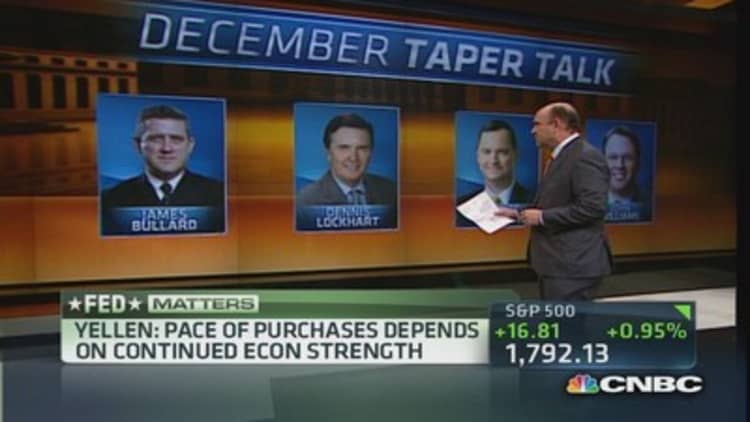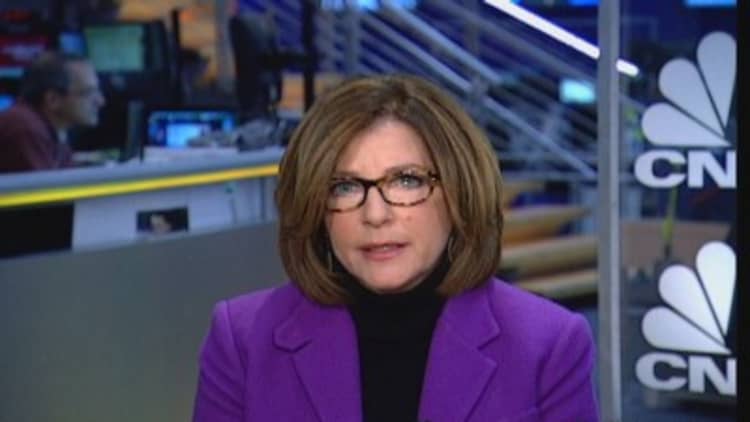Investors could be in store for some surprises next year, according to investment bank Morgan Stanley, which says yields on two and 10-year Treasurys could end 2014 at 2 percent in two different extreme scenarios.
Many analysts expect benchmark 10-year yields, which have spiked over 100 basis points this year on talk of Federal Reserve tapering, to head higher from current levels around 2.85 percent. Two-year yields, currently at 0.33 percent, are expected to stay low as interest-rate hike expectations stay muted.
(Read More: Where are Treasurys going? Just watch gold)
Morgan Stanley's base case is for yields on 10-year notes to end 2014 at 3.45 percent and for 2-year note yields to be trading at 1.15 percent.
But in two scenarios designed to capture the more extreme risks to the market, Morgan Stanley analysts said investors could be caught off guard if U.S. economic growth either disappoints or is much stronger than expected.

"A much stronger economic growth trajectory, coupled with an aggressive tapering schedule and less focus on rate guidance, brings rate hike expectations to January 2015," read the note.
(Read More: US Treasurys? No thanks,I'll take bank debt)
"[While] a return to muddle-through growth data and continued disinflation [could] prompt additional easing, including a 5.5% unemployment rate threshold and a 1.5% inflation floor," the note added.
Under the bank's most bearish scenario, the U.S. economy will just muddle through next year, leading to a series of disappointing data points.
(Read More: Is the Fed ready to taper?)
Weaker-than-expected growth could have a number of consequences such as encouraging the Fed to delay tapering its monetary stimulus program, which in turn would keep 10-year yields firmly below 3 percent.
Furthermore, disappointing data could lead the Fed to act to control deflation expectations by lowering the unemployment rate threshold and introducing an inflation floor at its January meeting, Morgan Stanley said.
All this could happen against a backdrop of reignited worries about growth in the euro zone and emerging markets, refueling appetite for Treasurys as a safe haven and pushing 10-year yields down to 2 percent by the end of 2014, the bank added.

Other analysts agreed that a fall in 10-year yields to as low as 2 percent was an extreme scenario.
Viral Bhuta, portfolio manager at Singapore-based fixed income specialists UTI International, said it was likely that yields would head lower if tapering expectations were pushed out to the latter half of 2014, but that a low of 2 percent on 10-year yields was unlikely.
(Read More: The other 'taper'that could hit Treasurys)
"To get down to 2 percent you would have to see another round of stimulus. So far U.S. economic data has been improving, so it's more likely that tapering will happen early next year," he said.
Bhuta said it was unlikely that the bullish sentiment towards U.S. Treasurys seen in recent years would return.
And at the short-end
At the shorter end of the curve, Morgan Stanley outlined a scenario where yields on 2-year notes, which tend to reflect the market's interest-rate expectations, spike to 2 percent by the end of 2014.
Market participants could be dramatically under-estimating the recovery of the U.S. economy next year and the boldness of the Fed, said the bank.
(Read More: Fed's dreaded 'taper' may not hurt after all)
A decision to taper the asset-purchase program by $25 billion at this week's meeting and a wrapping up of tapering by April could mean taper talk could quickly turn into talk of interest-rate hikes in early 2015, pushing yields on short-date bonds curve sharply upwards,according to Morgan Stanley.
"If rate hike expectations do get stronger, then yes, we might see a rise, but I don't expect a rise to 2 percent, it will be much more gradual," said UTI International's Bhuta.
— By CNBC's Katie Holliday: Follow her on Twitter @hollidaykatie


